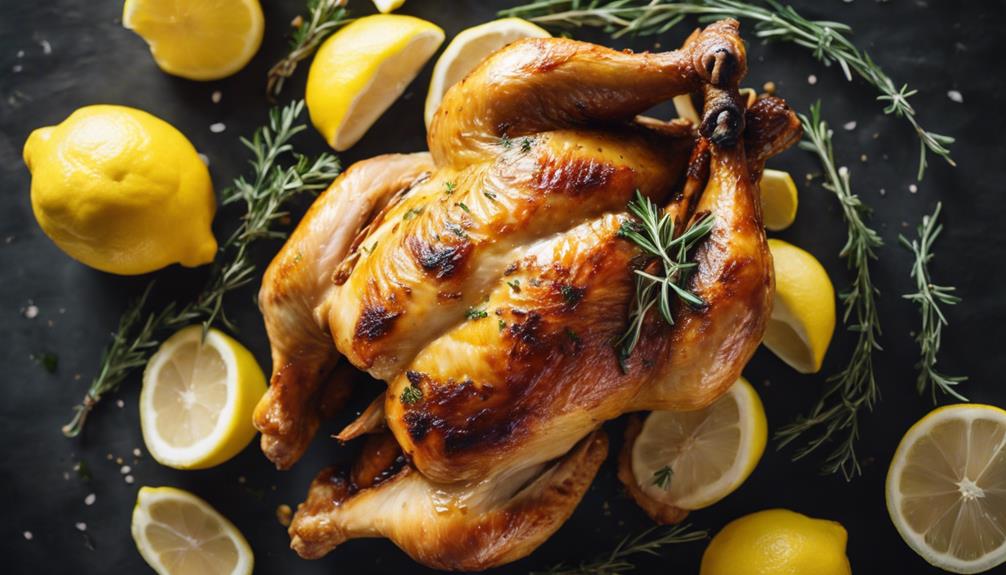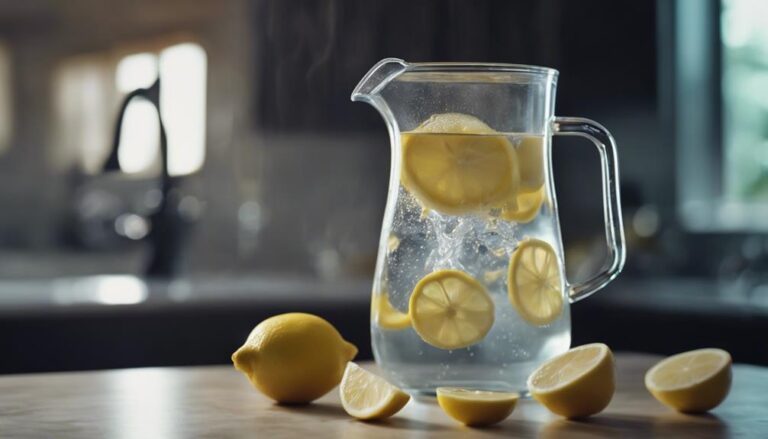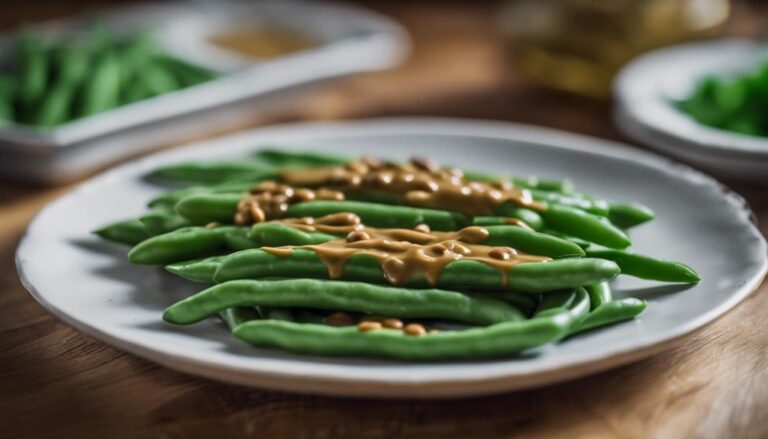Sous Vide Whole Roasted Chicken With Lemon and Thyme
Enhance your culinary skills with a Sous Vide Whole Roasted Chicken marinated in zesty lemon and aromatic thyme. Seal the seasoned chicken in a bag, submerge it in a water bath at 165°F for juiciness. Guarantee precise cooking by using a reliable thermometer and proper sealing. Searing post-cooking gives a crispy texture. This method locks in moisture and tenderness, producing a delightful dish. Want to discover more flavorful combinations and techniques for this succulent chicken?
What You Will Learn Here
- Season whole chicken with lemon, thyme, and other herbs for flavor.
- Vacuum-seal chicken to retain moisture and infuse flavors evenly.
- Sous vide at 165°F for juicy, tender chicken with enhanced taste.
- Finish by searing for a crispy skin and added texture.
- Experiment with different herb and spice combinations for unique flavors.
Origin of Sous Vide
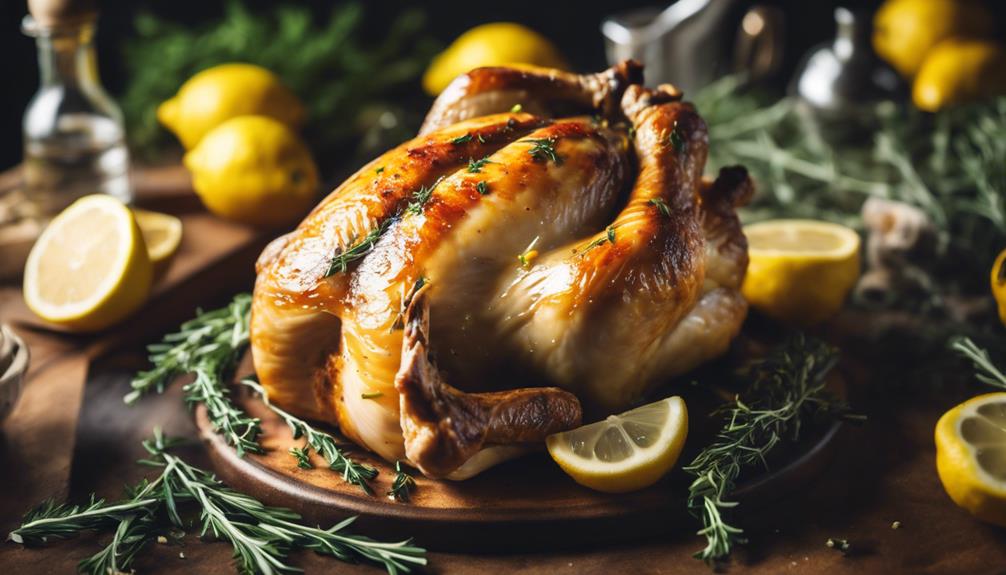
Sous Vide cooking, originating from French culinary practices, involves vacuum-sealing food in bags and cooking it in precise water temperatures. Understanding the history of Sous Vide can provide insight into its evolution from a professional kitchen technique to a popular home cooking method.
Advances in modern technology have made Sous Vide more accessible, with precision cookers and immersion circulators enhancing the cooking experience.
Sous Vide Cooking Method
Originating in France in the 1970s, the sous vide cooking method revolutionized culinary techniques with its precise temperature control and sealed cooking environment. Sous vide offers numerous benefits, such as retaining the natural flavors and nutrients of ingredients while ensuring consistent results.
To master sous vide techniques, start by vacuum-sealing seasoned food in a bag and submerging it in a water bath set to the desired temperature. Choosing the right sous vide equipment, like an immersion circulator and vacuum sealer, is essential for successful cooking. Tips for sous vide cooking include properly sealing the bags to prevent leaks and ensuring that the water level remains constant throughout the cooking process.
Mastering sous vide will elevate your culinary skills and impress your guests with perfectly cooked dishes.
History of Sous Vide
The roots of sous vide cooking can be traced back to innovative French chefs in the 1970s who sought to revolutionize traditional culinary techniques. These pioneering chefs experimented with sous vide techniques, recognizing the historical significance and potential of this method.
Through the evolution of sous vide methods, a culinary innovation was born, changing the way food was prepared and cooked. By vacuum-sealing ingredients and cooking them at precise temperatures in a water bath, these chefs discovered a way to enhance flavors, textures, and overall dining experiences.
The historical significance of these early experiments laid the foundation for modern sous vide technology, showcasing the transformative power of embracing new cooking methods.
Modern Sous Vide Technology
With advancements in culinary technology, the evolution of sous vide cooking has revolutionized the way chefs prepare and cook food, enhancing flavors and textures in ways previously unattainable. One of the key sous vide benefits is precision cooking, where ingredients are cooked at precise temperatures for extended periods, resulting in consistent doneness throughout the food. This method guarantees that your whole roasted chicken will be perfectly cooked from edge to edge, with no risk of overcooking.
Sous vide equipment, such as immersion circulators, plays an essential role in this process by accurately controlling the water temperature to within tenths of a degree. This level of control allows you to achieve restaurant-quality results in the comfort of your own kitchen, making sous vide a game-changer in the culinary world.
Key Ingredients for Flavor
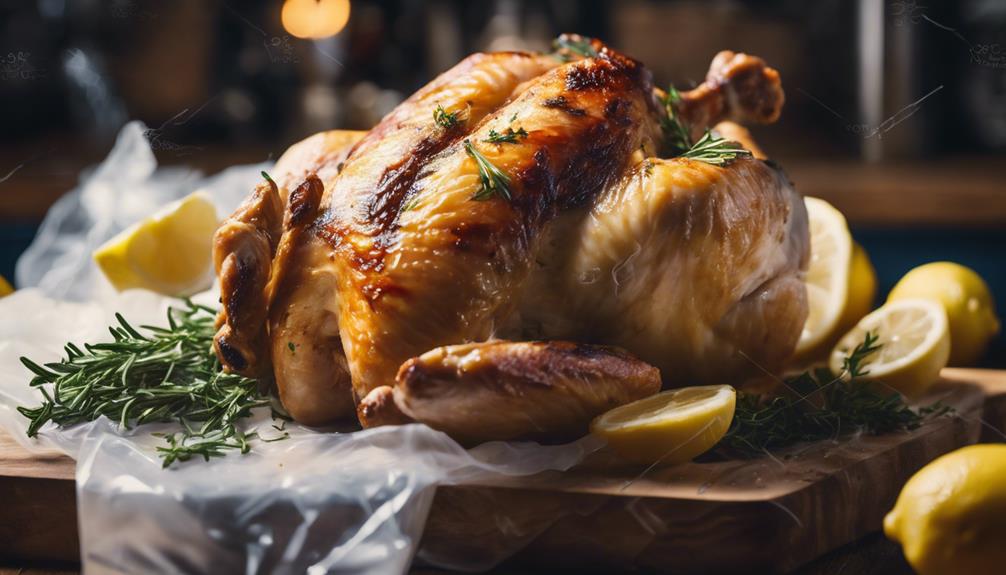
To infuse your sous vide whole roasted chicken with depth and complexity, consider incorporating a blend of aromatic herbs and spices. When selecting key ingredients for flavor, keep in mind the following:
- Flavor Profiles: Experiment with a mix of herbs like thyme, rosemary, and sage to create a harmonious blend that will elevate the taste of your chicken.
- Seasoning Techniques: Utilize techniques such as dry brining or creating a spice rub to enhance the flavors and guarantee that every bite is packed with deliciousness.
- Taste Preferences: Cater to different taste preferences by adjusting the amount of salt, pepper, and other seasonings to suit your personal liking or the preferences of those you're serving.
Trending Chicken Dishes
Explore exciting chicken dishes like the Sous Vide Lemon Chicken Recipe, Herb-Infused Sous Vide Chicken, and the classic Sous Vide Chicken Cordon Bleu.
These trending recipes offer a fresh take on traditional chicken dishes, infusing them with new flavors and cooking techniques to elevate your culinary experience.
Get ready to impress your taste buds with these innovative and delicious chicken creations.
Sous Vide Lemon Chicken Recipe
For this trendy chicken dish, the Sous Vide Lemon Chicken Recipe offers a burst of citrus flavor that elevates the succulent chicken to a whole new level. The tangy marinade infuses the chicken with a revitalizing zing, making each bite a delightful citrusy experience.
- Vibrant Citrus Marinade: The combination of fresh lemon juice, zest, and a hint of thyme creates a bright and flavorful marinade that perfectly complements the tender chicken.
- Sous Vide Precision: Using sous vide cooking techniques ensures that the chicken is cooked evenly throughout, resulting in juicy and perfectly tender meat.
- Serving Perfection: The Sous Vide Lemon Chicken Recipe guarantees a restaurant-quality dish that will impress your guests with its delicious flavors and succulent texture.
Herb-Infused Sous Vide Chicken
Infuse your chicken with a symphony of aromatic herbs through the precise technique of sous vide cooking. This method guarantees that the flavors penetrate every fiber of the chicken, resulting in a tender and flavorful dish that's sure to impress. Here are three key points to keep in mind when preparing herb-infused sous vide chicken:
- Enhanced Flavor: Sous vide cooking allows the herbs to infuse into the chicken breast slowly, enhancing the taste and aroma.
- Moisture Retention: By cooking the chicken breast in a vacuum-sealed bag, the moisture and natural juices are retained, resulting in a succulent and tender texture.
- Uniform Cooking: Sous vide ensures that the chicken is evenly cooked from edge to edge, guaranteeing a consistent doneness throughout the breast.
Sous Vide Chicken Cordon Bleu
Indulge in a gourmet experience with Sous Vide Chicken Cordon Bleu, a modern twist on a classic dish that promises to elevate your culinary skills.
Key Points to Note:
- Flavor Variations & Presentation Ideas:
- Experiment with different cheeses like Gruyère or Swiss for unique flavor profiles.
- Enhance presentation by topping the chicken with a sprinkle of fresh herbs or a drizzle of creamy Dijon sauce.
- Consider serving alongside a crisp green salad or buttery mashed potatoes for a well-rounded meal.
- Sous Vide Cooking Techniques & Time-Saving Tips:
- Utilize sous vide cooking for precise temperature control, ensuring juicy chicken every time.
- Prep multiple servings at once and store in the fridge for quick searing and serving during busy weeknights.
- Try prepping the chicken the night before to save time on the day of cooking.
Sous Vide Temperature Recommendations
When preparing sous vide dishes, it's important to nail the ideal temperatures for safe and delicious results.
You'll find essential guidelines for cooking poultry like whole roasted chicken with precision and perfection.
Keep in mind temperature control tips to guarantee your sous vide cooking is excellent every time.
Ideal Sous Vide Temps
What's the ideal temperature for sous vide cooking a whole roasted chicken to achieve the juiciest and most flavorful results?
When it comes to sous vide cooking techniques for poultry preparation, setting your water bath to 145°F (62.8°C) is a great starting point. This temperature guarantees the chicken is perfectly cooked, tender, and retains its natural juices while being infused with the aromatic flavors of lemon and thyme.
Cooking your whole roasted chicken at this precise temperature for a few hours allows the meat to reach ideal doneness without becoming dry or tough. This sous vide tip ensures a moist and succulent chicken that pairs beautifully with the citrusy brightness of lemon and the earthy notes of thyme.
Safe Cooking Guidelines
To guarantee safe and precise cooking when using sous vide techniques, it's essential to follow recommended temperature guidelines for different types of food. Food safety is of utmost importance when it comes to cooking methods like sous vide. Proper temperature control is vital in ensuring that the food reaches the necessary level of doneness while eliminating any harmful bacteria.
Different cooking techniques require specific temperature ranges to achieve the desired results without compromising food safety. By adhering to the recommended sous vide temperature guidelines, you can rest assured that your whole roasted chicken will be cooked to perfection, tender and succulent, while also maintaining the highest standards of food safety.
Temperature Control Tips
For precise sous vide cooking, maintaining accurate temperature control throughout the process is key to achieving the best results with your whole roasted chicken. Temperature accuracy is essential in sous vide cooking to guarantee that the chicken is cooked safely and perfectly.
Set your sous vide water bath to 165°F (73.9°C) for tender and juicy chicken. Check the water temperature regularly with a reliable thermometer to secure cooking precision.
Make sure to seal the chicken properly in a vacuum-sealed bag to prevent any water from entering during the cooking process, which can impact the temperature.
Final Thoughts
To wrap up, consider experimenting with different seasonings to enhance the flavor profile of your sous vide whole roasted chicken. While sous vide benefits the chicken by locking in moisture and tenderness, the right blend of herbs and spices can take it to the next level. Don't be afraid to try out different combinations like rosemary and garlic, smoked paprika, or even a touch of cumin for a unique twist on this classic dish.
When it comes to sous vide cooking hacks, tips can make a big difference in the outcome of your chicken. For a crispy skin finish, pat the chicken dry after sous vide cooking and sear it in a hot skillet or with a kitchen torch for a few minutes. This will give your chicken that perfect golden crust while keeping the meat juicy and flavorful.
In your culinary journey, remember that sous vide is a versatile technique that allows for precision and consistency in cooking. By exploring various flavors and techniques, you can create a sous vide whole roasted chicken that will delight your taste buds and impress your guests.
Frequently Asked Questions
Can I Use a Regular Oven Instead of a Sous Vide Machine?
Yes, you can use a regular oven instead of a sous vide machine. When oven roasting, the cooking method differs from sous vide. Sous vide offers precise temperature control, whereas oven roasting provides a more traditional method.
While sous vide locks in moisture, oven roasting can still produce flavorful results with crispy skin. Adjust cooking times and temperatures accordingly to achieve the desired flavor profiles when switching from sous vide to oven roasting.
How Can I Achieve a Crispy Skin on the Chicken?
To achieve a crispy skin on your chicken using the oven method, consider using an air fryer for a quick and effective finish.
Seasoning options like salt, pepper, and herbs can enhance the flavor.
Additionally, utilizing a brining technique can help lock in moisture and add depth to the taste.
Is It Necessary to Truss the Chicken Before Cooking?
When cooking a whole chicken, trussing isn't always necessary. Trussing benefits include a more compact shape for even cooking.
However, you can achieve similar results without trussing by using methods like spatchcocking or butterfly-cutting the chicken. These techniques promote even cooking and help the chicken retain moisture.
Experiment with different methods to find what works best for your desired outcome.
Can I Use Other Herbs Besides Thyme and Lemon?
You can certainly experiment with different herbs when making your roasted chicken. Herb substitutions can provide exciting flavor variations. Consider using rosemary for a more robust taste or sage for an earthy note.
Cooking variations like marinating the chicken in a blend of herbs overnight can enhance the flavors further. Don't be afraid to modify the recipe to suit your preferences and create a unique dish tailored to your taste buds.
How Long Can the Sous Vide Chicken Be Stored in the Fridge?
When storing sous vide chicken in the fridge, remember that food safety is crucial. To keep it fresh and safe, store the cooked chicken in an airtight container for up to 4 days. This guarantees the flavors are preserved and the chicken stays moist.
Always check for any signs of spoilage before consuming to make sure you're enjoying a delicious and safe meal.
Conclusion
Overall, the sous vide whole roasted chicken with lemon and thyme is a game changer in the world of chicken dishes. The precise temperature control of sous vide cooking guarantees a juicy and flavorful end result every time.
The combination of bright lemon and aromatic thyme adds a revitalizing twist to this classic dish. Elevate your culinary skills and impress your guests with this mouthwatering sous vide chicken recipe.
